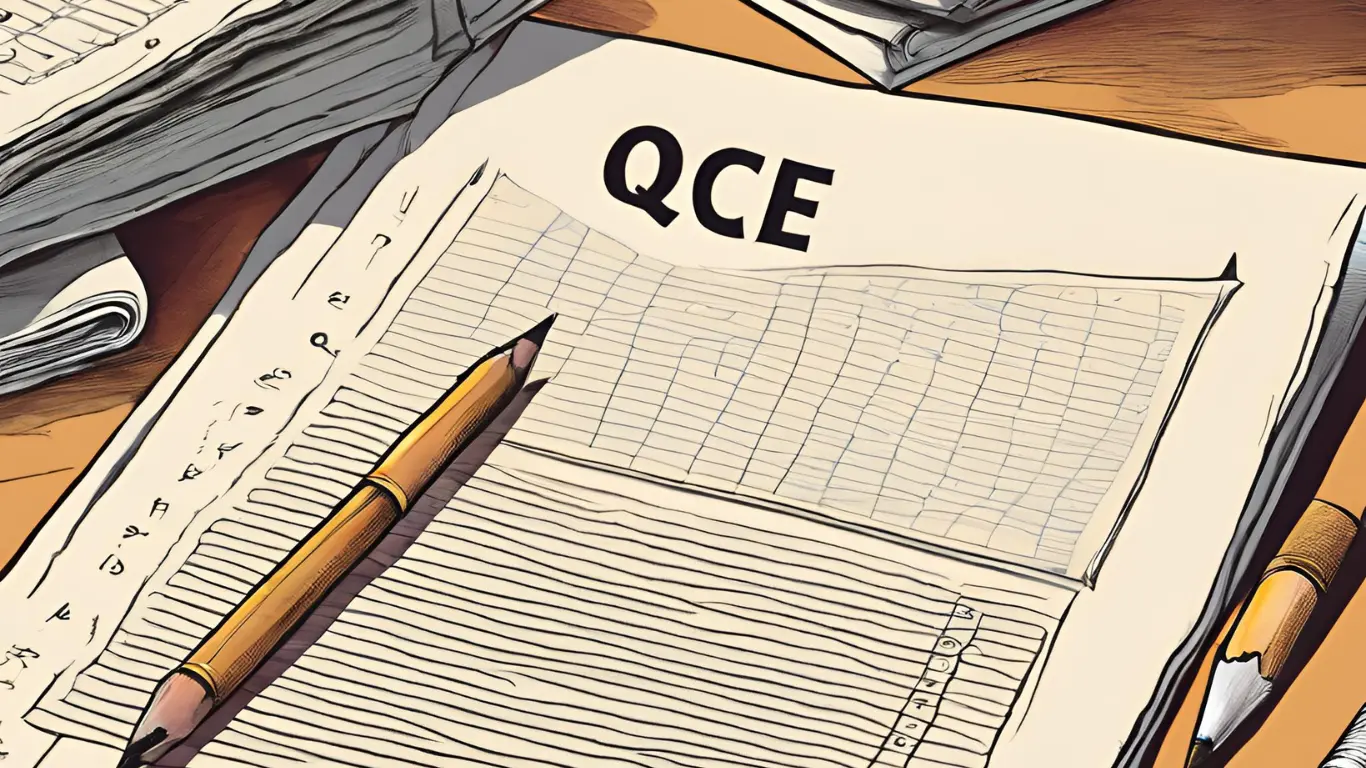
Are you a Queensland high school student aiming for top marks in your QCE General Mathematics exam? Look no further! This comprehensive guide will equip you with all the essential information and strategies to ace your exam and secure that coveted A grade.
The Queensland Certificate of Education (QCE) General Mathematics course is designed to challenge and prepare students for future academic and career pursuits. Whether you're eyeing a university placement or simply striving for personal excellence, mastering this subject is crucial.
In this blog post, we'll cover everything from the syllabus breakdown to exam format, effective revision techniques, and last-minute preparation tips. We'll also explain why practising with past papers is your secret weapon for success in the QCE General Mathematics exam.
So, grab your calculator and get ready to boost your confidence and mathematical prowess. Let's dive into the world of QCE General Mathematics and pave your way to that well-deserved A!
Summary of the General Mathematics Units
Below we will cover Units 3 and 4 in General Mathematics and all the sub-topics you will need to understand to do well on your General Mathematics exam:
Unit 3: Bivariate
data and time series analysis, sequences and Earth geometry
Topic 1: Bivariate data analysis 1
Identifying and describing associations between two categorical variables (5 hours)
- Understand the meaning of bivariate data.
- Construct two-way frequency tables and determine the associated row and column sums and percentages.
- Use an appropriately percentaged two-way frequency table to identify patterns that suggest the presence of an association.
- Understand an association in terms of differences observed in percentages across categories in a systematic and concise manner, and interpret this in the context of the data.
Identifying and describing associations between two numerical variables
- Identify the explanatory variable and the response variable.
- Construct and use a scatterplot to identify the association between two numerical variables .
- Describe an association between two numerical variables in terms of direction (positive/negative), form (linear/non-linear) and strength (strong/moderate/weak).
- Calculate Pearson’s correlation coefficient, r, from raw data using technology, and interpret it to quantify the strength of a linear association.
- Calculate the coefficient of determination, R(^2), from raw data using technology, and use it to assess the strength of a linear association in terms of the explained variation.
- Use the correlation coefficient, r, to determine the coefficient of determination, R(^2), and vice versa.
Topic 2: Bivariate data analysis 2
Fitting a linear model to numeric data
- Model a linear relationship by using technology to fit a least-squares line to the data, in theform of y = mx + c where m is slope (gradient) and c is y-intercept.

- Construct a residual plot and use it to assess the appropriateness of fitting a linear model to the data.
- Interpret the y-intercept and slope (gradient) of the fitted line.
- Distinguish between interpolation and extrapolation.
- Use the equation of the least-squares line to make predictions.
- Recognise and explain the potential dangers of extrapolation
Association and causation
- Recognise and explain that an observed association between two variables (categorical and/or numerical) does not necessarily mean that there is a causal relationship between them.
- Identify and communicate possible non-causal explanations for an association, including coincidence or the influence of another variable.
- Solve practical problems by identifying, analysing and describing associations between two variables (categorical and/or numerical).
Topic 3: Time series analysis
Describing and interpreting patterns in time series data (3 hours)
- Construct and use time series plots.
- Describe time series plots by identifying features, including trend (long-term direction, e.g. increasing/decreasing), seasonality (systematic, calendar-related movements) and irregular fluctuations (unsystematic, short-term fluctuations).
Analysing time series data (8 hours)
- Smooth time series data by calculating a simple moving average using the mean or median for an odd number of data, including the use of spreadsheets.
- Deseasonalise a time series by calculating the seasonal indices using the average percentage method, including the use of spreadsheets.
- Fit a least-squares line to model long-term trends in time series data.
- Solve practical problems that involve the analysis of time series data
Topic 4: Growth and decay in sequences
The arithmetic sequence
- Use recursion to generate an arithmetic sequence.
- Display the terms of an arithmetic sequence in both tabular and graphical form and demonstrate that arithmetic sequences can be used to model linear growth and decay in discrete situations.

- Use arithmetic sequences to model and analyse practical situations involving linear growth or decay, e.g. analysing a simple interest loan or investment, calculating a taxi fare based on the flag fall and the charge per kilometre, calculating the value of an item using the straight-line method of depreciation
The geometric sequence
- Use recursion to generate a geometric sequence.
- Display the terms of a geometric sequence in both tabular and graphical form and demonstrate that geometric sequences can be used to model exponential growth and decay in discrete situations

- Use geometric sequences to model and analyse practical situations involving geometric growth and decay (use of logarithms not required), e.g. modelling the growth of a bacterial population that doubles in size each hour, calculating the value of an item using the diminishing-value method of depreciation.
Topic 5: Earth geometry and time zones
Locations of the Earth
- Understand the meaning of great circles.
- Understand the meaning of angles of latitude and longitude (in decimal degrees, and degrees and minutes) in relation to the equator and the prime meridian respectively.
- Locate positions on Earth’s surface given latitude and longitude, e.g. using a globe, map, GPS and other digital technologies.
- State latitude and longitude for positions on Earth’s surface, e.g. investigating a map of Australia and locating boundary positions for Aboriginal peoples’ and Torres Strait Islander peoples’ language groups, Australian landmarks or local land boundaries.
- Calculate angular distance and distance between two places on Earth on the same meridian
- D = 111.2 x angular distance where D is distance in kilometres
- Calculate angular distance and distance between two places on Earth on the same parallel of latitude where is distance in kilometres and is latitude
- D = 111.2cos0 x angular distance where D is distance in kilometres and 0 is latitude
- Solve practical problems involving latitude, longitude, angular distance and distance
Time zones
- Understand the meaning of Greenwich Mean Time (GMT), International Date Line and Coordinated Universal Time (UTC).
- Understand the link between longitude and time.
- Determine the number of degrees of longitude for a given time difference.
- Calculate time differences between two places on Earth.
- Solve practical problems involving time zones, making allowances for daylight saving where necessary, e.g. seasonal time systems used by Aboriginal peoples and Torres Strait Islander peoples, making phone calls, broadcasting events, travelling, preparing an itinerary.

Unit 4: Investing and Networking
Format of the exam
External assessment is developed and marked by the QCAA. The external assessment in General Mathematics is common to all schools and administered under the same conditions, at the same time, on the same day.
The exam is worth 50% of your total mark.
Assessment objectives
- Recall mathematical knowledge.
- Use mathematical knowledge.
- Communicate mathematical knowledge.
- Evaluate the reasonableness of solutions.
- Justify procedures and decisions.
- Solve mathematical problems
Specifications
- Consists of two papers:
- Paper 1 — degree of difficulty of questions: simple familiar
- Paper 2 — degree of difficulty of questions: complex familiar and complex unfamiliar
- asks students to respond to a number of unseen short response questions relating to Units 3and 4
- Answers may be multiple choice and/or long-form
- Students will be asked to:
- Interpret unseen stimulus
- Calculate using algorithms
- Draw or label graphs, tables or diagrams
- Use assumed knowledge from Units 1 and 2
Paper 1
- Weighted at 30% - contains short response simple familiar questions, including multiple choice
- Time allowed
- Perusal time: 5 minutes
- Working time: 90 minutes
- The QCAA provides the QCAA General Mathematics formula book.
- Students
- May use a handheld QCAA-approved scientific calculator
- Must not bring notes or other resources into the examination.
Paper 2
- Weighted at 20% - contains short response complex familiar and complex unfamiliar questions
- Time allowed
- Perusal time: 5 minutes
- Working time: 90 minutes
- The QCAA provides the QCAA General Mathematics formula book.
- Students
- May use a handheld QCAA-approved scientific calculator
- Must not bring notes or other resources into the examination.
How to Study Effectively for QCE General Mathematics
Preparing for the QCE General Mathematics exam requires a strategic approach tailored to the unique aspects of the Queensland curriculum. Here are some specific tips to help you succeed:
- Practice Past Papers
- Access past QCE General Mathematics papers from the QCAA website
- Time yourself to simulate exam conditions
- Review your answers using the provided marking guides
- Master Calculator Skills
- Ensure you can efficiently use your calculator for statistical calculations, matrix operations, and graphing
- Practice complex calculations to save time during the exam
- Develop Problem-Solving Techniques
- QCE exams often include real-world application questions
- Practice interpreting worded problems and translating them into mathematical models
- Review Formula Sheet
- Familiarize yourself with the formula sheet provided in the exam
- Practice using these formulas in various contexts
- Focus on Showing Working
- The QCE exam rewards clear, logical working out
- Practice presenting your solutions step-by-step
- Time Management
- Allocate time for each question based on its mark value
- Leave time to check your answers at the end
.webp)
Master list of Past Papers
Why Past Papers Are the Best Way to Revise for QCE General Mathematics
Past papers are an invaluable resource for QCE General Mathematics revision. Here's why they should be a central part of your study strategy:
1. Familiarity with QCAA Question Structures
The Queensland Curriculum and Assessment Authority (QCAA) tends to use consistent question structures in the QCE General Mathematics exam. These structures can differ significantly from those in textbooks or other resources. By practising with past papers, you'll:
- Become comfortable with the QCAA's unique question phrasing
- Learn to quickly interpret what each question is asking
- Understand how to structure your responses for maximum marks
2. Rapid Identification of Challenging Areas
Working through past papers allows you to:
- Quickly pinpoint which types of questions you find difficult
- Identify specific content areas where you need more practice
- Recognise patterns in your mistakes, helping you address underlying misconceptions
For example, you might discover that you consistently struggle with questions on critical path analysis or statistical investigations, allowing you to focus your revision efforts accordingly.
3. Time Management Practice
QCE General Mathematics exams have a strict time limit. Past papers help you:
- Identify which sections of the exam require more time
- Practice allocating your time effectively across different question types
- Improve your speed in calculations and problem-solving
You might find, for instance, that you need to allocate more time to the extended response questions or to complex matrix operations.

4. Exposure to Real-World Applications
QCE General Mathematics often includes questions based on real-world scenarios. Past papers will:
- Familiarise you with how mathematical concepts are applied to practical situations
- Improve your skills in interpreting graphs, tables, and data sets in context
- Help you practice translating word problems into mathematical models
5. Understanding Mark Allocation
By reviewing past papers and their marking schemes, you'll gain insight into:
- How marks are distributed across different types of questions
- What level of working out is required for full marks
- Common mistakes that cost students marks
6. Confidence Building
Regular practice with past papers can significantly boost your confidence by:
- Reducing exam anxiety through familiarity with the format
- Providing a realistic assessment of your preparedness
- Allowing you to track your improvement over time
Caution Note
While past papers are extremely valuable, it's important to note that the QCE curriculum can change over time. When using older past papers (more than 3-4 years old):
- Be aware that some topics may no longer be part of the current syllabus
- Check for any changes in calculator policies or formula sheets provided
- Verify that the exam structure (time allowed, question types) hasn't changed significantly
It's advisable to prioritise the most recent past papers and always cross-reference with the current QCE General Mathematics syllabus document to ensure you're focusing on relevant content.
By making past papers a key part of your revision strategy, you'll be well-prepared for the unique challenges of the QCE General Mathematics exam, setting yourself up for success in this crucial Queensland qualification.
Final Exam Preparation Tips
Night Before the Exam
- Light Review:
- Briefly go over key formulas and concepts.
- Don't try to learn new material at this stage.
- Prepare Materials:
- Pack your approved calculator, spare batteries, and stationery.
- Double-check you have your student ID and know your exam location.
- Calculator Check:
- Ensure your calculator is working correctly and is in radians mode (if applicable for trigonometry questions).
- Relaxation:
- Engage in light exercise or relaxation techniques to reduce stress.
- Avoid heavy studying that might increase anxiety.
- Early Bedtime:
- Aim for at least 8 hours of sleep to ensure you're well-rested.
Day of the Exam
- Healthy Breakfast:
- Eat a nutritious breakfast to fuel your brain. Consider foods like oatmeal, eggs, or whole-grain toast.
- Arrival Time:
- Plan to arrive at the exam venue at least 30 minutes early.
- This allows time to find your seat and calm your nerves.
- Last-Minute Review:
- If you wish, do a quick glance over your summary notes, but avoid intensive studying.
- Focus on staying calm and confident.
- During the Exam:
- Use the 15-minute perusal time wisely to read through all questions and plan your approach.
- Start with questions you're most confident about to build momentum.
- For complex problems, clearly show all your working out - partial marks are often awarded in QCE exams.
- Keep an eye on the time, allocating roughly 1 minute per mark.
- Challenging Questions:
- If you encounter a difficult question, don't panic. Move on and return to it later if time allows.
- Remember, the QCE General Mathematics exam often includes some challenging questions designed to differentiate top performers.
- Final Check:
- If time permits, review your answers, especially for calculation-heavy questions.
- Ensure you've answered all parts of multi-part questions.







